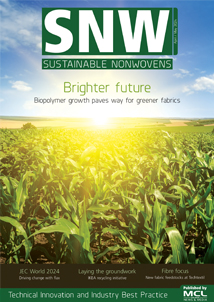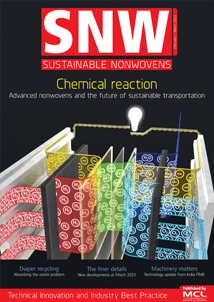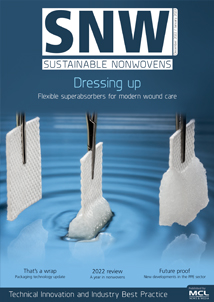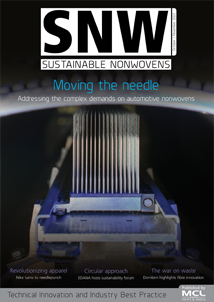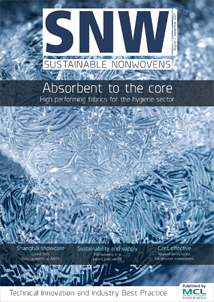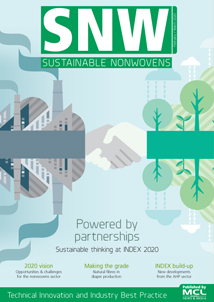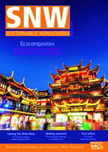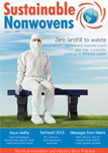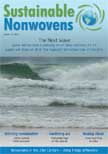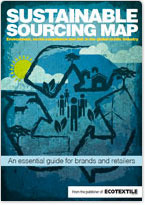The increasing consumption of nonwovens products across the world is being accompanied by an equal amount of growth in the vital machine-made packaging sector
A key requisite for the packaging of nonwovens items in the hygiene and medical sectors is that they should have the longest possible shelf life while also ensuring that the product complies with all legally specified hygiene and sterilization standards.
Another increasingly important aspect is the sustainability of the product throughout the supply chain, from the raw material production to waste disposal.
The result of these two demands is that nonwovens are becoming more and more attractive as packaging material, both for manufacturers and users.
Throughout the world packaging manufacturers in different industries are stepping up their endeavours to ensure the best possible sustainability for the production and waste disposal of their products prompting the rise of key trends such as volume reduction and reusability
Recyclable
Recyclability is a requirement that multi-national packaging specialist Mondi is keen to address. The company has recently collaborated with Essity and Dow to create new, recyclable secondary packaging for Essity’s feminine care products, using renewable materials and post-consumer recycled content that reduces the use of fossil-based materials.
Essity’s feminine care towels were previously packed in bags that already used 50% renewable materials. Extensive research and testing by Mondi however, resulted in the recommendation of a new solution that aligns with Essity’s packaging goals – to work towards 100% recyclability and to use up to 85% biomass, renewable or recycled material in all bags where up to 25% are recycled plastics.
The new packaging contributes by using a renewable material and by-product from the paper making industry that is produced from circular feedstock based on the ISCC (International Sustainability and Carbon Certification) mass balance approach. The packaging also contains mechanically recycled content from post-consumer material. Mondi worked with long-term supplier Dow and other companies along the value chain to find the most suitable resin formulation for this solution. The end result is an extruded film that is printed on and converted into a bag.
Providing the same high-level of protection as the previous alternative, the solution prevents moisture and light damage, has strong sealing properties and delivers outstanding print quality to maintain on-shelf appeal for Essity’s European recognised brands such as Bodyform, Libresse, Nana and Nuvenia.
“The challenge was to find the best combination of renewable and recycled content that maintains product quality and the production efficiency already enjoyed by Essity said Marjo Kuisma, responsible for consumer flexibles regional sales at Mondi. “We tested several options until we found the most suitable solution. Working in collaboration with Essity and Dow validates our EcoSolutions approach – we go back to the start and ask the right questions to ensure we create the best possible solution for our customers.”
Kraft
Recyclability was also a key consideration for American Hygienics Corporation, a global leader in wet wipes and baby diaper manufacturing, which has introduced a sustainable alternative packaging option which uses Kraft paper for its most eco-friendly baby diaper range of products.
AHC’s paper bag offers global hygiene product manufacturers an additional option to bio-based and compostable packaging and has a number of attributes that will be attractive to the end consumer. The bags are easy-to-open, recyclable and sustainably sourced, with FSC certification, significantly reducing carbon footprints.
“AHC’s long-term vision towards sustainability is driving its R&D efforts to give the world a better sustainable and eco-friendly choice,” said group directors Kalpesh Parmar. “Following tremendous demand for more eco-friendly packaging and interest in reducing the single use plastic in our products, we have been constantly looking for the right option. Finally, we came up with the paper bag for our green diaper range that has the ability to claim itself more sustainable and recyclable.
Among other targets in the years to come, AHC aims to offer more biodegradable and compostable products to reduce landfill waste while committing to carbon-neutral manufacturing operations.
Partnership
Hayat is regarded as one of the leading FMCG companies (Fast Moving Consumer Goods) based in Turkey, offering products in the hygiene, home care, tissue, and personal health categories that reach over 100 countries. With demand continuing to grow the company has recently taken delivery of its 50th Optima bundler, expanding its 18-year partnership with the packaging technology specialist.
Optima and Hayat have worked closely together since 2003, and in 2021 this culminated in the delivery of the 50th Optima bundler.
Hayat, which is the world’s fifth largest branded baby diaper manufacturer, ordered an Optima bundler for the first time in 2003 – the first model offered through the company for packaging paper hygiene products. This year the 50th bundler was supplied to Hayat – a special occasion that both companies are proud of.
“When we entered the market for baby diapers and sanitary napkins, we were looking for a world-class partner for packaging,” Ibrahim Güler, vice president Operations at Hayat, said. “Of all the potential partners, Optima stood out with its high standards and clever solutions. Today, Optima also meets the requirements of our high speed production lines, which are Industry 4.0 compatible, perfectly.” Ivair Santos, sales director, South America at Optima do Brasil, added: “Hayat expects the best technologies to ensure maximum efficiency. With valuable feedback, Hayat has played a part in the success story of the Optima bundler over the years.” Other multipackers are already in production for Hayat.
During their 18 year partnership, Optima says it has continued to optimize the bundlers and adapt the technology to customer requirements. Today, for example, the welded seams of the multi-unit packs, which consist of PE film, are formed with a servo-controlled unit. This makes format changes significantly quicker. Hayat is also able to accommodate the almost tool-free format change. The Optima bundler can be switched to a new format in 15 to 30 minutes.
Pre-packed paper hygiene products are fed inline to the OPTIMA BD12 bundler during production. For multi-line packaging, the bundler creates single or multi-layered formations. The bags are made in the machine from the PE film roll, then the product formations are inserted into the bags and closed with a welded seam.
The multi-unit packs have a width of up to 800 mm, a length of up to 1,200 mm and a height of up to 400 mm. The output is twelve multi-unit packs per minute, which almost entirely covers the market requirements. All Optima bundlers are produced at the Brazilian site in Vinhedo and comply with the high standards of the international special-purpose machine manufacturer based in Schwaebisch Hall, Germany.
The Optima bundlers are used at various Hayat locations worldwide. The company employs over 9,000 employees across 21 plants.
Extra large
Size is also a key consideration for Denmark’s Tentoma, which has launched a new extra large packaging machine for nonwoven fabrics that offers high capacity and greater operating speeds.
The new XL Power packaging machine enables 6-sided sealed packaging of up to 19-metre-long products. For packaging of shorter products, XL Power can also stretch film for even more products per packaging cycle, which increases the packaging speed.
The first XL Power is already built and sold to replace an orbital wrapper. It is for a packaging line at a production site, where it will pack panels in varied sizes, all the way up to 13.5 m in length.
XL Power has been designed to produce more force for stretching film. It means that XL Power can load and stretch even more film on the gripper arms during the packaging process opening opportunities for more packaging improvements. Most obvious is the increased maximum length of the products, which now can be packed and protected by 6-sided waterproof packaging. Depending on product shape and film thickness, it is now possible to pack and seal products up to 19 meters long, an increase in product length of 50%, compared to the standard RoRo StretchPack XL machine.
The XL Power also offers increased packaging speeds. The ability to load and stretch even more film on the gripper arms increases the packaging speed when using the “Semiflow packaging” principle. “Semiflow packaging” enables the packaging of multiple products in a row before the machine needs to load more film on the gripper arms.
XL Power can load and stretch even more film on the gripper arms, so it is possible to pack even more products in a row compared to the XL machine, the company says. A comparison between XL and XL Power shows that when the XL machine packs 210 products per hour, the new XL Power machine packs 260 products.
Technical speaking, the new XL Power is a reinforced version of the proven RoRo StretchPack XL packaging machine.
Legacy
Essity has also been expanding its reach in the converting sector with a move for the US professional wiping and cleaning company Legacy Converting in a US$40 million deal.
Legacy offers products within the categories of sanitizing and disinfecting wet-wipes, chemical-ready wipes and dry wipes.
Essity is the world’s largest supplier of products and services in the market for professional hygiene with its leading Tork brand. Legacy Converting was founded in 2004 and manufactures the Everwipe brand of roll and folded wipes in a variety of formats, including pop-up canister, bucket and resealable packs. Customers are mainly found in the Industrial and Office Supply, Public Interest, Commercial and Healthcare market segments. Legacy Converting, Inc. is located in New Jersey.
For the first nine months of 2021, Legacy Converting, Inc. reported net sales of $15.1 million with an EBITDA of $2.5 million.
Welcoming the deal, Don Lewis, president, Professional Hygiene, Essity said: “As a leading global hygiene and health company, we are committed to offering innovative sustainable hygiene products and services. With the acquisition of Legacy Converting, Inc. we will expand our wiping and cleaning product offering and further strengthen our presence in key customer segments in the North American market.”
Jumbo
A further major development in the wipes packaging sector is a new launch from global machinery manufacturer Shemesh Automation. Building on the success of its Citadel-R monobloc bagger for round refill and consumer wipes, the company is once again first to market with a ground-breaking offering for Jumbo Wipes makers.
Most industries are undergoing transformational change in the wake of Covid-19 coupled with increased concerns around climate change, and the nonwoven wipes sector is no different. In fact, Shemesh first developed the Citadel series in response to two emerging industry trends.
First, wipes manufacturers are beginning to transition away from rigid packaging such as canisters and buckets towards flexible packaging. This not only means they use less plastic, but also flexible packs take up less space – allowing manufacturers to make savings on transport costs and reduce their carbon footprint.
Second, whilst the initial Covid-related surge in demand for consumer wipes may have settled down post-pandemic, it’s clear that the market for jumbo wipes in flexible packs, commonly used in hospitals and gyms, is still growing apace.
Responding to this growing market trend and building on the successful launch of its Citadel-R model, Shemesh has developed the perfect solution for manufacturers of wipes in flexible jumbo-sized bags who are looking to enhance their production with fast, space-saving automation.
A stand-alone monobloc unit, the Citadel-J automatically stuffs jumbo sized (typically in the 600 sheet-count to 1,200 count range) nonwoven rolls into premade bags, accurately fills them with liquid (typically 3 to 5 litres) while providing constant support beneath the heavy bag, seals the bags and then ejects the finished product at speeds of 10-15 packs per minute (depending on product-specific variables).
Citadel-J is designed to connect seamlessly to existing slitter/rewinders, allowing manufacturers to benefit from complete A-Z hands-free operation.
Shemesh Automation CEO, Shai Shemesh explains that much like all the best products, Citadel-J came by way of a genuine response to a real unmet market need: “Citadel-J is a great example of a business listening to its customers and bringing to market a machine that really offers an answer to requirements that had been left unaddressed by the wider market for too long. Now, thanks to Citadel-J, manufacturers of jumbo wipes in flexible packs have a cutting-edge automated solution that will allow them to make savings to their carbon footprint while enhancing production efficiencies - and their bottom line.”
Accuracy
Lotion filling and mixing capabilities are at the heart of wet wipes manufacturing, says American Hygienics Corporation (AHC) – the quality of lotion mixing determines the efficacy of wipes and requires efficiency and precision.
Dosing errors, the degree of homogeneity, mixing ratio errors, formula protection and sanitization issues are among the common challenges encountered by wet wipes manufacturers, especially those still employing manual mixing operations.
Headquartered in Jiaxing, Zhejiang, AHC has 40 production lines at its two plants in China, with a gross annual output of over a billion wipes a year. Its manufacturing facilities are ISO13485 certified and make regular and over-the-counter drug wipe products as well as carrying US EPA site registrations and collaborating with relevant licensees on infection control products.
The company’s in-house blending systems are equipped with world-class compounding techniques and completely automatic operation. Computerised mixing operations ensure the accuracy of liquid mixing process while allowing for an automated monitoring process based on configured data including the adding sequence, mixing ratio, mixing time, pressure and feeding dosing.
Automation has more than doubled production efficiency, with a qualified product rate of over 99%, the company reports.
The complete system works on the basis of barcode scanning, starting from the inventory. Every tank has a barcode, which contains information concerning ingredient codes, weights and adding orders. Computerised mixing operations ensure the system will only run step by step, while all mixing is done in the same process and sequence all the time. An intelligent manufacturing execution system for mixing operations enables utmost precise control over formulas and keeps them protected and confidential.
The key to avoiding mistakes when matching mixing tanks with filling lines is the one-to-one loop, which means each individual mixing tank is connected to only one filling line, according to operations manager Neel Kapadia.
“This allows you to have error free transfer and makes the cleaning and sanitizing processes easier,” he explains. “Moreover, due to the unique design, AHC has been able to shorten the transfer piping by 40%, which again reduces bioburden and cuts down carbon footprint.”
AHC’s premix mixing capability allows more complex chemicals to be blended easily as its premix tanks are equipped with high RPM mixers (200x compared with a master tank) and some contain homogenizers so they are more powerful and make it easier to blend chemicals. The premix tanks are also jacketed, which allows temperature to be controlled to dissolve chemicals and greater bonding with other chemicals to be achieved.
After mixing operations, mixing tanks need to be thoroughly cleaned, which is no easy job. Chemicals must be removed from surfaces, leaving no toxic residues. Instead of using chemicals, AHC employs a hot water sanitization system, which allows 85˚C hot water sanitization and is specifically designed to minimise bioburden. The advantages are no chemical residues and no corrosion, along with being able to reach hard-to-access areas.
“AHC treats all liquid blending with the same care as regulated drugs,” said Nilesh Parmar, CEO and founder of AHC, “We have made great investments in our liquid processing infrastructure to make sure that we deliver an industry-leading level of quality, efficiency and precision in our manufacturing process while minimising bioburden to keep both ourselves and our customers ever more reassured about the quality of our wet wipes.” SNW








